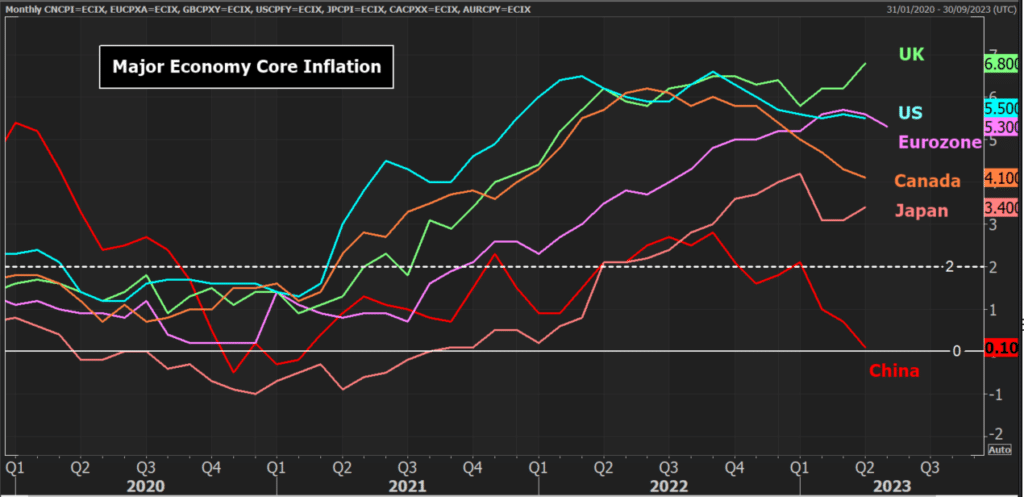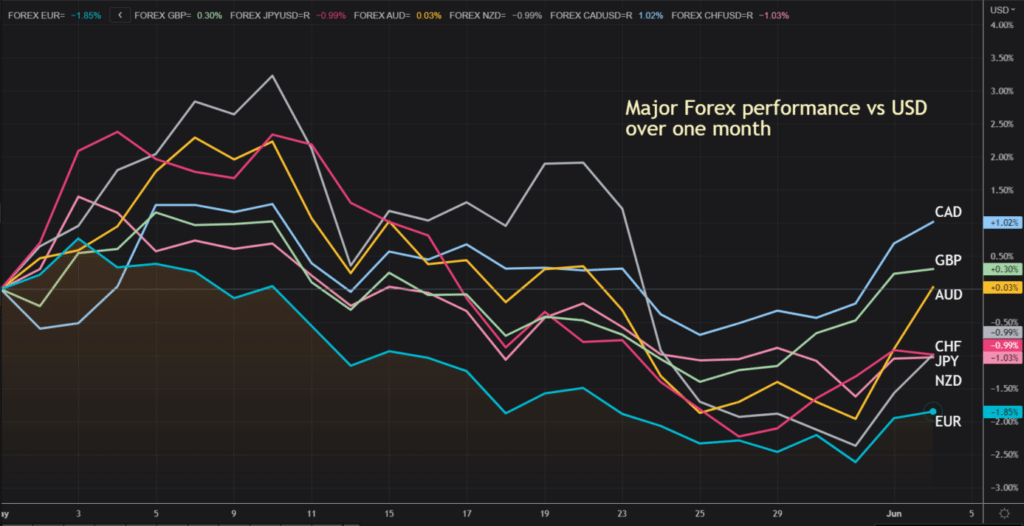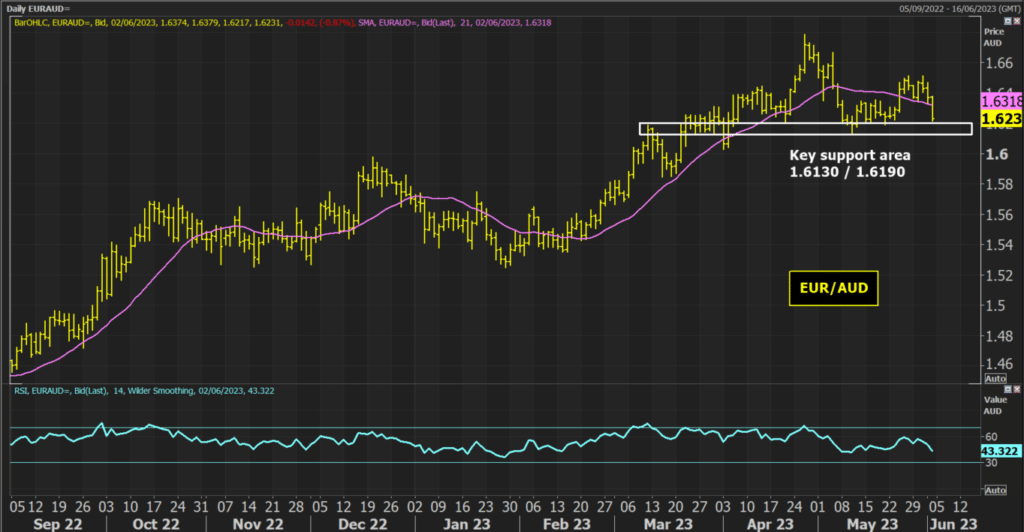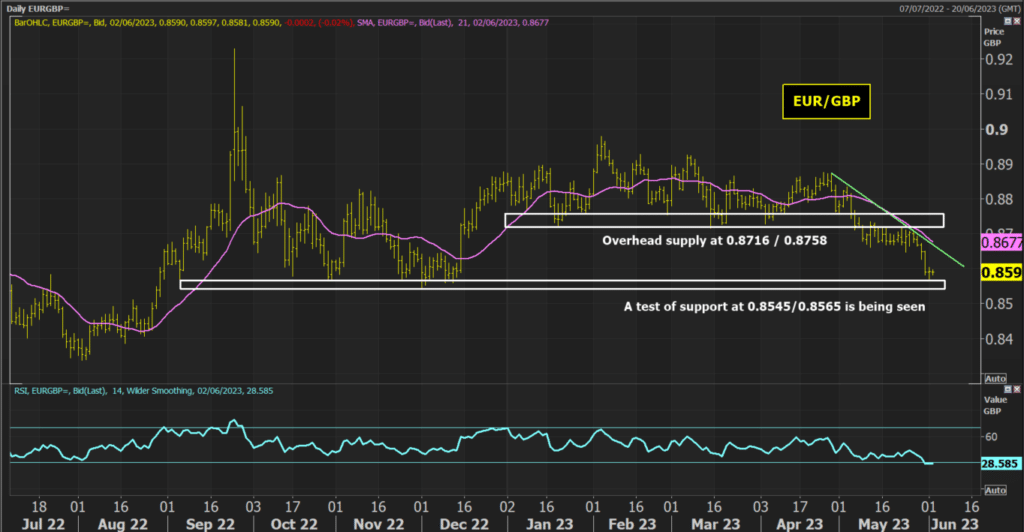Eurozone inflation was lower than forecast in May. Core inflation fell to 5.3% in a move that saw two consecutive months of declines for the first time since mid-2021. With GDP faltering this will mean that the ECB will be more cautious in hiking rates aggressively from here. This is likely to weigh on the performance of the EUR, with crosses such as EUR/AUD particularly being eyed.
- Eurozone inflation and growth with downside surprises in May
- The dovish impact on the European Central Bank
- EUR is underperforming on its major crosses

Eurozone inflation falls sharply in May
Inflation finally seems to be starting to trend lower in the Eurozone. Core HICP inflation has dropped from 5.6% in April to 5.3% in May. Interestingly also, month-on-month inflation was flat for the Euro area, whilst seeing declines in Spain, France and Germany.
Energy prices have fallen sharply in the past year. The price of European natural gas has fallen back to around two-year lows at €23 per megawatt hour. A year ago it was sitting at €83, before the incredible spike higher to €339 in August. This is all helping headline inflation to reduce. Furthermore, with PPI inflation levels also in sharp reverse this will also be playing into the disinflation that is taking hold in core prices.

The May data will certainly come as something of a relief for the European Central Bank (ECB). However, an upward trend in wage growth will still be of concern. Furthermore, the economic growth data is also sluggish, with the block’s largest economy, Germany, officially in a technical recession.
The Eurozone is the first of the major economies to report inflation data for May, but a new downward trend is beginning to take shape. Sharp reductions in China’s CPI and PPI have indicated a slowing economic recovery and contributed to reducing pricing pressures around the world. The supply chains of Eurozone manufacturers are reflecting this, with good inflation falling decisively.
The key question is how this impacts the ECB but also relative to other central banks too.
Less pressure on the ECB to hike
The ECB is already set up for a hike in June. However, this inflation data, along with the disappointing growth numbers will be making the Governing Council think long and hard about subsequent decisions.
Markets are pricing for hikes in June and July. The Governing Council will want to be sure that the trend of core inflation is falling before it pauses on tightening. However, that could be it.
However, looking at other central banks such as the Bank of England and the Reserve Bank of Australia, markets are reacting to more hawkish signals. UK inflation caused a jolt higher to pricing for Bank of England hikes, whilst the Reserve Bank of Australia seems to be on a renewed hawkish path too. As for the Federal Reserve, the prospect of skipping a hike in June is still feeding through and weighing on the USD.
EUR is underperforming
Looking across the performance of major currencies, we see that the EUR continues to languish at the bottom of the pile. Performance versus the USD over the past month has the EUR consistently lagging.

The EUR has also lagged the recovery that major currencies have posted throughout this week. However, there is one mover that stands out against the EUR, and that is the recovery in the Aussie. This is driving a strong move lower in EUR/AUD. There is also support being eyed on EUR/GBP.
EUR/AUD approaching a test of key support
With a big jump in the AUD and the lagging performance of the EUR, there has been a sharp move to the downside in EUR/AUD. Looking at the technical analysis, it now means that a key support area between 1.6130/1.6190 is being tested.

Already with the daily RSI faltering at 60 and back under 50, we see the upside momentum of the February to May rally having been lost. This would turn corrective on a medium-term basis if the support at 1.6130 were to be breached. It would complete a two-month top pattern and imply a correction down towards 1.5500. The resistance at 1.6515 is now key.
EUR/GBP is also eyeing important support
On EUR/GBP, there is an even important support now under threat. Throughout Q4 2022 the support at 0.8545/0.8565 provided a floor. However, this floor is again under threat as GBP has strengthened in the past few weeks.

The momentum is bearish, with the RSI below 30. This may be stretched but also it reflects the extent of the negative momentum. Given the sharp lurch lower in the pair this week, there could be a near-term unwind, back towards the one-month downtrend. However, there is a decisive negative medium-term negative configuration on the RSI which would point towards rallies being sold into. A downside break below 0.8545 would open the lows of August 2022 to around 0.8340.